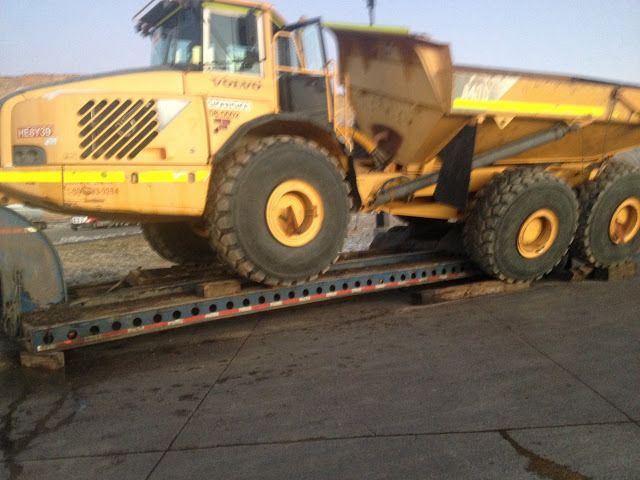Questions About Flatbed
Topic 11917 | Page 2

Just to be clear, you have to be logged into the forum he linked it from.
So how do you distribute the weight with a spread axle trailer?
Michael when you are using a trailer with a spread axle you are allowed 40,000 pounds on your spread axles. The only way to distribute that weight is by moving the load on the trailer to a different position. Don't worry about it. in the last 2.5 years I had one load that was over just a little on the spread axles - it just doesn't happen that often, and if it does you are probably over on your gross also. I've had loads that were over on gross and still legal on the spread axles. For the most part the places that you are loading at will already know how to load their product on your trailer so that it will be right. I've had countless steel mills show me right where to put my dunnage on the trailer so that when they load me it will be perfectly legal, and they always get it right. The one time I was over weight on my spread axles was a pre-loaded trailer I picked up with an unusual load of pipe that was arranged oddly because it was multiple stops, and like I said it was barely over. The scales that I passed over just let it go because it was so slight.
Secondly, when it comes to lifting the lumber tarps, I have been reading and hearing there is a proper technique that makes lifting those heavy things a piece of cake.
Here's a copy of part of a conversation from another thread where I was explaining to Little Syster how to lift the tarps. It has a little other information in it, but I think you'll get the idea. Some tarps are heavier than others - many of the flat-bed operators are now using a three piece tarp system which reduces the weight you are dealing with considerably. I still use the old two piece full lumber tarps with full eight foot drops constructed with the heavier gauge vinyl - they usually weigh around 135 pounds in the good weather, in winter time there is no telling what they may weigh.
Listen Sunshine, I want you to try to think about this lifting aspect a little differently than you've probably been doing up till now. It seems that you are focusing on improving your strength, and that is good, but realistically where the problem lies is in your lifting technique. I've seen some smaller ladies than you handling this job. Just because you can lift 90 pounds up over your head in a gym is a completely different thing from lifting that bulky rolled up tarp out on the job site. let me explain the technique, and then I'll share a little tip with you about getting it on that shelf. You want to stand the tarp up on it's end first. Then half bending your body and half squatting you are going to need to get one hand underneath the bottom of the tarp (gripping in the rolled edges down there) and take the other arm and bear hug that thing up against that same arms shoulder area. The tarp will be standing in between your knees at this point. Now, while trying to stand up and straighten up your torso, you squeeze the tarp against that shoulder and pull up with your hand underneath the bottom until you get yourself up into an upright position. Now when you get yourself upright, you will have the tarp hugged up against your body with one hand still underneath the bottom, and the bottom of it is down around your mid thigh area. At this point you are simply going to give the tarp a few bounces with your body and your lower hand by bending your knees and bouncing your body upward so that with each bounce you are lifting that thing up higher against your body and holding it there in that position until you can get it up high enough to sort of roll it on up onto your shoulder. I recommend you go to a large building supply place like a Lowe's, Home Depot, or a Menard's and look at their rolls of roofing tar paper. See if you can find some that are close to the 90 pound weight amount and practice with those things. If you can get the technique down with that large roll, then you should be good to go. Now here's the promised tip: That shelf they are having you put the tarp on is just about the average height of a flat-bed trailer - that is why they chose that height. When you get the tarp into the position where it is hugged up against your body then all you've got to do at that point is keep bouncing it upward until you can get the top of the tarp five or six inches above the shelf. Then you are going to push the tarp against the shelf, and lower your top hand so that it is now at the bottom of the tarp along with your other hand, and both hands and arms are now supporting the full weight of the tarp. At this point you are going to use the edge of the shelf as a pivot point to get a little leverage to help you swing the tarp up onto the shelf. If you decide to purchase on of those rolls of roofing paper you can practice this at home, or you can probably find a way to practice it at the building supply warehouse if you want to save your self the expense. I hope this helps! I love your attitude and your gumption - keep at it and you'll be out there before you know it. And by the way, when you are out here doing this stuff, 90% of the time there will be a fork lift operator out here willing to help you get your tarps put where they need to be.
HOS:
Hours Of Service
HOS refers to the logbook hours of service regulations.New Reply:
New! Check out our help videos for a better understanding of our forum features

















Preview:










 TT On Facebook
TT On Facebook
You have to be logged into the forum to see that image. The op can see it because he was logged in and cached it.